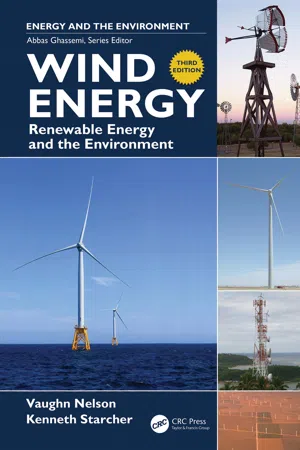
- 310 pages
- English
- ePUB (mobile friendly)
- Available on iOS & Android
eBook - ePub
Wind Energy: Renewable Energy and the Environment
About this book
The utilization of wind power and other renewable energy sources has been growing at a phenomenal rate. Wind Energy, Third Edition explores the wind industry from its inception in the 1970s to today; presents the design, aerodynamics, operation, control, applications, as well as different types of wind turbines. An overview of energy examines world consumption and use of fossil fuels, and includes a section on global climate change. It covers the characteristics of wind, such as shear, power potential, and turbulence, and discusses the measurement and siting of individual wind turbines and wind farms. It also discusses the political and economic factors regarding the adoption of wind as an energy source.
Features
-
- Includes updates throughout, and adds new material on wind forecasting, offshore wind, decommissioning and repowering wind farms, and more
-
- Illustrates the need for a shift to renewable energy through discussions on energy use and the order of magnitude estimates for the lifetime of fossil fuels
-
- Discusses the interconnection of wind turbines to utility grids, regulations on installation and operation, and the related environmental concerns
-
- Presents important economic considerations for the development of wind farms
-
- Provides an abundance of examples that highlight the real-world advantages of wind energy over fossil fuels
Frequently asked questions
Yes, you can cancel anytime from the Subscription tab in your account settings on the Perlego website. Your subscription will stay active until the end of your current billing period. Learn how to cancel your subscription.
At the moment all of our mobile-responsive ePub books are available to download via the app. Most of our PDFs are also available to download and we're working on making the final remaining ones downloadable now. Learn more here.
Perlego offers two plans: Essential and Complete
- Essential is ideal for learners and professionals who enjoy exploring a wide range of subjects. Access the Essential Library with 800,000+ trusted titles and best-sellers across business, personal growth, and the humanities. Includes unlimited reading time and Standard Read Aloud voice.
- Complete: Perfect for advanced learners and researchers needing full, unrestricted access. Unlock 1.4M+ books across hundreds of subjects, including academic and specialized titles. The Complete Plan also includes advanced features like Premium Read Aloud and Research Assistant.
We are an online textbook subscription service, where you can get access to an entire online library for less than the price of a single book per month. With over 1 million books across 1000+ topics, we’ve got you covered! Learn more here.
Look out for the read-aloud symbol on your next book to see if you can listen to it. The read-aloud tool reads text aloud for you, highlighting the text as it is being read. You can pause it, speed it up and slow it down. Learn more here.
Yes! You can use the Perlego app on both iOS or Android devices to read anytime, anywhere — even offline. Perfect for commutes or when you’re on the go.
Please note we cannot support devices running on iOS 13 and Android 7 or earlier. Learn more about using the app.
Please note we cannot support devices running on iOS 13 and Android 7 or earlier. Learn more about using the app.
Yes, you can access Wind Energy: Renewable Energy and the Environment by Vaughn Nelson,Kenneth Starcher in PDF and/or ePUB format, as well as other popular books in Scienze fisiche & Ingegneria elettronica e telecomunicazioni. We have over one million books available in our catalogue for you to explore.
Information
1 Introduction
Industrialized societies run on energy, and as third world countries industrialize, especially China and India with their large populations, the demand for energy is increasing. Economists look at monetary values (dollars) to explain the manufacture and exchange of goods and services. However, in the final analysis, the physical commodity is the transfer of energy units. While industrialized nations comprise only one-fourth of the population of the world, they use four-fifths of the world’s energy. Most of these forms are solar energies that fall into two classifications:
Stored solar energy: Fossil fuels—coal, oil, and natural gas—all of them are finite and therefore depletable.
Renewable energy: Radiation, wind, biomass, hydro, and ocean thermal and waves. Many people discount renewable solar energy; some even call it an “exotic” source of energy. However, it is the source of all food, most fibers, and heating and cooking in many parts of the world [1].
Other forms of energy are tidal (due to gravitation), geothermal (heat from the Earth), and nuclear (fission and fusion). In reality, geothermal is a form of renewable energy because, as heat, it is replenished from below when it is released through the Earth’s surface.
Fossil fuels are the main source of energy in most industrialized nations, however, the use of renewable energy has increased and there are goals for a substantial amount of renewable energy to replace fossil fuels. Based on the widespread use of fossil fuels, and combined with growing demands and an increasing world population, the need to switch to other energy sources is imminent. Whether this change will be rational or catastrophic depends on the enlightenment of the public and their leaders.
1.1 HISTORY
The use of wind as an energy source began in antiquity. Vertical axis windmills for grinding grain were reported in Persia in the 10th century and in China in the 13th century [2]. At one time, wind was a major source of energy for transportation (sailboats), grinding grain, and pumping water. Windmills and water mills were the largest power sources before the invention of the steam engine. Windmills, numbering in the thousands, for grinding grain and pumping drainage water were common across Europe, and some were even used for industrial purposes such as sawing wood. As the Europeans colonized the world, windmills were built all over the world.
The principal long-term use of wind (except for sailing) has been to pump water. In addition to the famous Dutch windmills, another famous example is the historical use of sail-wing blades to pump water for irrigation on the island of Crete. On these windmills, one of the blades had a whistle on it to notify the operator to change the sail area when the winds were too high.
1.1.1 DUTCH WINDMILLS
At one time, over 9,000 windmills operated in The Netherlands. A number of different designs were used, from the early post mills to the taller mills whose tops rotated to keep the blades perpendicular to the wind. Today, Dutch windmills are famous attractions in The Netherlands (Figure 1.1).
Machines for pumping large volumes of water from a low head were as large as 25 m in diameter and most parts were made of wood. Even the helical pump, an Archimedean screw, was made of wood (Figure 1.2). The mills were quite sophisticated in terms of the aerodynamics of the blades. A miller would rotate (yaw) the top of the windmill from the ground with a rope attached to a wooden beam on the cap so the rotor would be perpendicular to the wind. Others used small fan rotors to yaw the big rotors. The rotational speed and power were regulated by the amount of sail on the blades.

FIGURE 1.1 Dutch windmills, World Heritage Site, Kinderdijk, The Netherlands.
The miller and his family lived in the bottom of the windmill, and the smoke from the fireplace was vented to the upper floors to control insects. Fire was a major hazard faced by thatched windmills.
1.1.2 FARM WINDMILLS
Farm windmills were of the utmost importance when Americans were settling in the Great Plains of the United States [3]. From 1850 on, water pumping windmills were manufactured in the tens of thousands. The early wood machines (Figure 1.3) have largely disappeared from the landscape except for a few in isolated farmhouses and museums.
By 1900, most windmills were made of metal. They still had multi-blade vanes, and the blades were 3–5 m in diameter (Figure 1.4). Although the use of farm windmills peaked in the 1930s and 1940s, when over six million were in operation, these windmills are still manufactured and continue to pump water for livestock and residence uses. The American Windmill Museum in Lubbock, Texas has an outstanding collection of farm windmills (Figures 1.5 and 1.6) from the early wood mills to the later metal types. The museum collects small wind turbines (Figure 1.7), blades for several small wind turbines, and a large 1.5-MW General Electric wind turbine on display. Electricity is provided on-site by a Vestas V47 660-kW turbine on a 40-m tower.
Most farm windmills currently in use are in Africa, Argentina, Australia, Canada, and the United States. Because farm windmills are fairly expensive, a resurgence of design changes has focused on creating less expensive systems. Another major advance is the development and commercialization of stand-alone electric–electric systems for pumping enough water for irrigation, village use, or both [4].
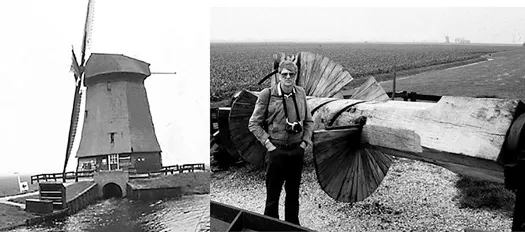
FIGURE 1.2 Dutch windmill (thatched) museum. Notice water flow at bottom of windmill into the canal. Nelson in much younger days next to helical pump.
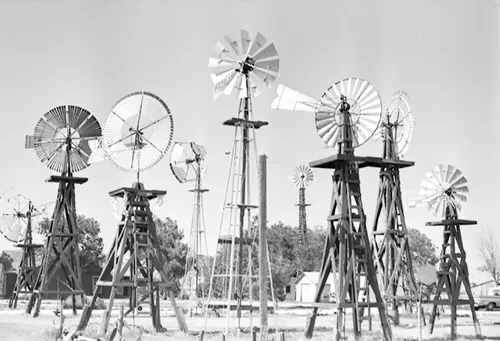
FIGURE 1.3 Historical farm windmills at J.B. Buchanan farm near Spearman, Texas. Windmills have since been moved to an outdoor museum in Spearman.

FIGURE 1.4 Farm windmill in the Southern High Plains of the United States.
The farm windmill proves that wind energy is a valuable commodity, even though the proportion of the energy market is small. For example, an estimated 30,000 farm windmills operate in the Southern High Plains of the United States. Even though their individual power output is low (0.2–0.5 kW), they collectively provide an estimated output of 6 MW.
If the windmills for pumping water were converted to electricity from the electric grid, the transition would require around 15 MW of thermal power from a generating station and over $1 billion for transmission lines, electric pumps, and other equipment. This does not consider the dollars saved in fossil fuel with an energy equivalent of 130 million kilowatt-hours (kWh) per year (equivalent to 80,000 barrels of oil per year). Because many of these windmills are 30 years old or older, and maintenance costs are $250–$400 per year, farmers and ranchers are seeking alternatives such as solar pumps rather than purchasing new windmills.
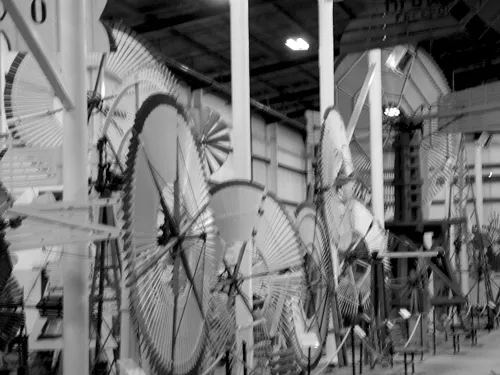
FIGURE 1.5 Some of the many old windmills in the pavilion, at the American Windmill Museum in Lubbock, Texas. (Photo courtesy of Coy Harris.)
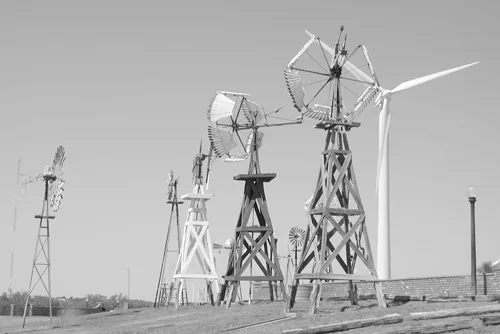
FIGURE 1.6 Old windmills on towers at the American Windmill Museum in Lubbock, Texas. The Vestas V47 is in the background.
In 1888, Charles Brush built a windmill to generate electricity. The device was based on a rotor (large number of slats) and tail vane of a large farm windmill. The wooden rotor (17 m in diameter) was connected to a direct current generator through a 50:1 step-up gearbox to produce around 12 kW of power in good winds. The unit operated for 20 years but the low rotational speed was too inefficient to produce electricity. For example, a wind turbine with the same-diameter rotor would produce around 100 kW.
1.1.3 WIND CHARGERS
As electricity became commercially practical, some isolated locations were too far from generating plants and transmission lines were too costly. Therefore, a number of manufacturers built stand-alone wind systems to generate electricity (Figures 1.8 and 1.9), based on a propeller-type rotor with two or three blades. Most of the wind chargers had direct current generators (6–32 V) and some later models generated 110 V. The electricity was stored in wet-cell lead–acid batteries that required careful maintenance for long life.

FIGURE 1.7 Small wind turbines at American Windmill Museum in Lubbock, Texas. Parentheses indicate turbine size in meters and rated power in kilowatts. Left to right, Urban Green Technology (1.4 × 0.9, 1.0), Air Dolphin (1.2, 1.0), Honeywell (2.2, 1.0), Raum (4.0, 4.0), Windspire (3.0 × 0.6), Skystream (Southwest Windpower, 3.7, 2.1). Tower heights are around 10 m.

FIGURE 1.8 Direct current 100-W, Windcharger with flap air brakes at U.S. Department of Agriculture’s ARS Wind Station at Bushland, Texas. Notice 4-kW and 100-kW Darrieus wind turbines in the background.
These systems with two or three propeller blades are quite different from farm windmills that utilized several blades covering most of the rotor-swept area. Farm windmills were well engineered for pumping low volumes of water, but too inefficient for generating electri...
Table of contents
- Cover
- Half Title
- Series Page
- Title Page
- Copyright Page
- Table of Contents
- Preface
- Acknowledgments
- Authors
- Chapter 1 Introduction
- Chapter 2 Energy
- Chapter 3 Wind Characteristics
- Chapter 4 Wind Resource Assessment
- Chapter 5 Wind Turbines
- Chapter 6 Design of Wind Turbines
- Chapter 7 Electrical Issues
- Chapter 8 Performance
- Chapter 9 Siting
- Chapter 10 Applications and Wind Industry
- Chapter 11 Institutional Issues
- Chapter 12 Economics
- Index